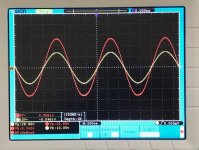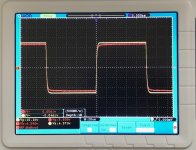Some Oscope screenshots...
Maximum output un-clipped is 26.8vpp into 8ohms or 11Wrms output (yellow is preamp input, red is MoFo output):
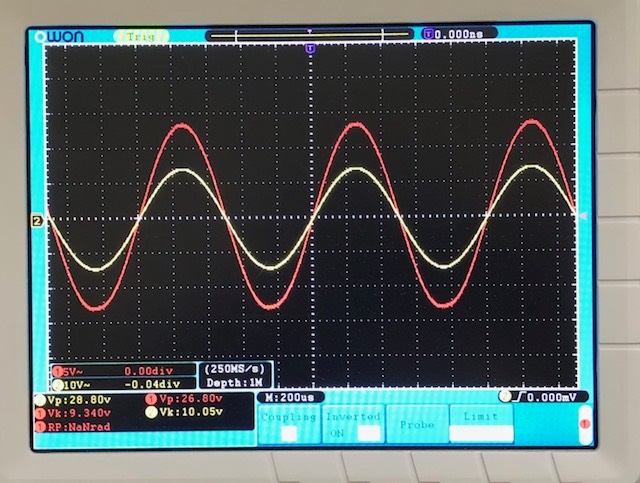
9.6vpp 1kHz square wave (output is red):
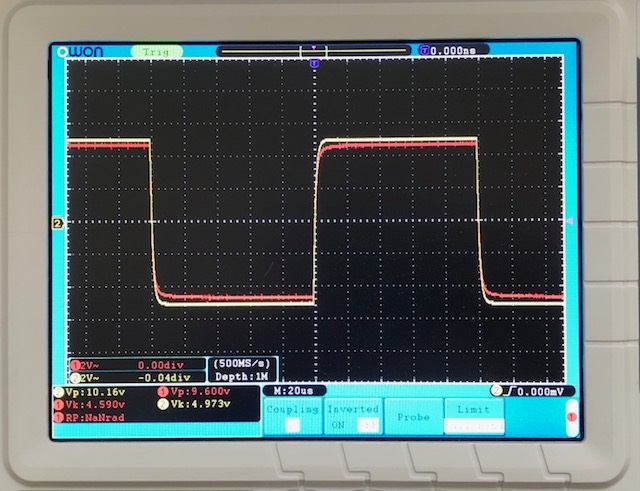
With all the above data, and listening tests, the MoFo is a fine Class A amp capable of nice performance. Ability to drive 11Wrms on 19v Vcc is impressive actually. Gain of my MoFo appears to be actually -0.63dB not 0dB.
Maximum output un-clipped is 26.8vpp into 8ohms or 11Wrms output (yellow is preamp input, red is MoFo output):
9.6vpp 1kHz square wave (output is red):
With all the above data, and listening tests, the MoFo is a fine Class A amp capable of nice performance. Ability to drive 11Wrms on 19v Vcc is impressive actually. Gain of my MoFo appears to be actually -0.63dB not 0dB.
Attachments
Last edited:
While I'm waiting for the PCBs and components to arrive, I'm wondering a couple things. This is my first ground-up amp build - I've done some amp repairs and a lot of speaker building in the past, so I'm probably in the 'know enough to be dangerous' camp. Please be gentle. 😀
My heatsinks are about twice as effective as the minimum mentioned in the PDF. Any problems running at 4 ohms with a robust enough power supply?
I'll be driving things with a 7V RMS preamp signal. Not sure this is enough for full output with unity gain. But is should be enough for decent listening levels with loudspeakers that have a 94dB efficient 4 ohm midbass section and 107dB efficient 16 ohm compression driver (I'm doing a fully active design based on the BMS TMM speakers shown at this year's RMAF).
Since i have not yet ordered the chokes and power supply parts, I am looking for opinions on whether to go regular (19V) or big (24V) mofo for my intended use.
I'd originally intended to power the BMS TMMs with four channels of an Adcom GFA-6000, but this design was too cool to not try out.
My heatsinks are about twice as effective as the minimum mentioned in the PDF. Any problems running at 4 ohms with a robust enough power supply?
I'll be driving things with a 7V RMS preamp signal. Not sure this is enough for full output with unity gain. But is should be enough for decent listening levels with loudspeakers that have a 94dB efficient 4 ohm midbass section and 107dB efficient 16 ohm compression driver (I'm doing a fully active design based on the BMS TMM speakers shown at this year's RMAF).
Since i have not yet ordered the chokes and power supply parts, I am looking for opinions on whether to go regular (19V) or big (24V) mofo for my intended use.
I'd originally intended to power the BMS TMMs with four channels of an Adcom GFA-6000, but this design was too cool to not try out.
The preamp output of 7V RMS corresponds to a bit over 6W
into 8 ohms. The regular Mofo will handle that.
into 8 ohms. The regular Mofo will handle that.
My heatsinks are about twice as effective as the minimum mentioned in the PDF. Any problems running at 4 ohms with a robust enough power supply?
I'll be driving things with a 7V RMS preamp signal. Not sure this is enough for full output with unity gain.
Since i have not yet ordered the chokes and power supply parts, I am looking for opinions on whether to go regular (19V) or big (24V) mofo for my intended use.
For 4 ohms, you will need approx 1.4 times the current for the same power. But also 1.4 times less voltage. If I would optimize this amp for 4 ohm, I would lower the voltage and increase the current.
So I wouldn't go pass the 19V (maybe even a bit lower: more like 17V) but increase the current to at least 3 ampere. This way the heat is still manageable (for a big sink).
7 VRMS is not enough to get full output with this amp. You would need almost double this to get a 17V MoFo to its limit (there is a table somewhere in this thread). But it should be enough to produce a lot of noise with your speakers.😀
If you intent to use this preamp, I would definitely not use a high voltage power supply. With 7 VRMS you're getting about 10V peak. So a 12V MoFo would be enough. This way you also don't need a big current. 2A is sufficient.
Or like Dennis has said: the small MoFo is good enough for 7VRMS.
My 2 cents.
Last edited:
Nice thing with 24v SMPS, is ability to add a simple IRFP240 cap Mx to allow soft start (no thumps on or off), reduce AC line ripple by -45dB, and have a flat as a board noise floor. Voltage droput gives about 19v of super clean power. Don't underestimate the importance of needing a turn-on delay relay for sensitive compression drivers or 94dB sensitive speakers. With a cap Mx, the turn on is a gradual 10 second long ramp.
Here's a schematic - just replace IRF610 with IRFP240. As you can see, it's about 3 parts shy of a MoFo:
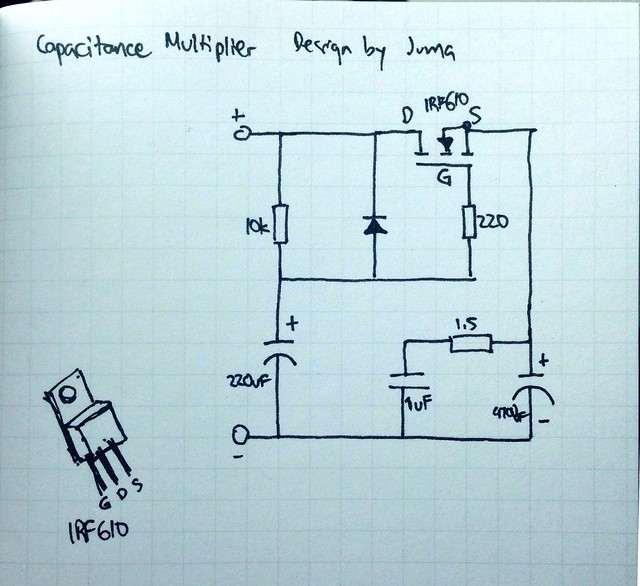
Juma's Easy-Peasy Capacitance Multiplier
Here's a schematic - just replace IRF610 with IRFP240. As you can see, it's about 3 parts shy of a MoFo:

Juma's Easy-Peasy Capacitance Multiplier
Last edited:
Any reason you cant tie two laptop supplies together +-+- to get twice the supply voltage? They float right?
Apologies if this has been addressed before.
Apologies if this has been addressed before.
Any reason you cant tie two laptop supplies together +-+- to get twice the supply voltage? They float right?
Apologies if this has been addressed before.
That can work but easier to use a cheap $6 10amp DC step up booster. Will get you any voltage up to 50v.
I have used two SMPS in series and center tap to GND for a dual rail PSU. You have to use SMPS with 2 prong line cords (ungrounded and floating) to do this.
I have a standard psu and no thumb on or off. Even not with my ears on the speaker. Nothing.
That's interesting, I never bothered running without the cap Mx. Perhaps the large inductor slows down the startup transient?
On similar SE Class A amps with a resistor current sink or a normal MOSFET CCS, there is a turn on thump without cap Mx.
Hi,
What is the gauge and length required to wind 50mH inductor on ferrite core ?
Thanks.
There appears to be a certain amount of magic surrounding transformer design. Magnetic fields being what they are, the parts to make it happen aren't so obvious. You could probably do a ferrite rod, but it would have noise, or an EI but that would take experimentation in the absence of... someone already doing it, with the same parts. Or an air core... we can do those! But they are BIG and have ohm losses now. And ergo bigger PSUs and chassis, and before you know it.. it's getting steampunk Frankenstein. And there is nothing wrong with that if it makes sound. The Mofo can be constructed with a myriad of parts and that seems pretty interesting if you ask me.
For 4 ohms, you will need approx 1.4 times the current for the same power. But also 1.4 times less voltage. If I would optimize this amp for 4 ohm, I would lower the voltage and increase the current.
So I wouldn't go pass the 19V (maybe even a bit lower: more like 17V) but increase the current to at least 3 ampere. This way the heat is still manageable (for a big sink).
If you intent to use this preamp, I would definitely not use a high voltage power supply. With 7 VRMS you're getting about 10V peak. So a 12V MoFo would be enough. This way you also don't need a big current. 2A is sufficient.
Or like Dennis has said: the small MoFo is good enough for 7VRMS.
My 2 cents.
For the 12 volt power supply version, there should be no problem using the smaller Hammond chokes, right? Lots of options to provide 12VDC......
At this point I'm sort of wed to the processor that will provide active crossover, active hi-pass and DSP functions for the DIY BMS speakers, so for the time being it's going to be 7VRMS input for the two pairs of MoFo amps. An older Velodyne ULD-15 servo sub will round out the bottom end, so bottom octave performance of the MoFo is not absolutely critical for me.
If you want a very nice high current, low distortion choke that can provide the measured data shown a few pages above, do a search on eBay for a MOT part number "MD-803AMR-1" - it is a very common low cost item salvaged from dead microwave ovens. Typically under $30 shipping included (in USA).
These measure about 67mH and 0.47ohm DCR. They weigh about 10lbs. The steel appears to be some sort of silicon (non-rusting) steel, e-beam welded at the seam to preserve the airgap.
These measure about 67mH and 0.47ohm DCR. They weigh about 10lbs. The steel appears to be some sort of silicon (non-rusting) steel, e-beam welded at the seam to preserve the airgap.
For the 12 volt power supply version, there should be no problem using the smaller Hammond chokes, right? Lots of options to provide 12VDC......
The smaller chokes (159ZC or 193T) are rated at 2A. The 159ZC has a bit higher inductance (60mH), so you can run the current a bit higher (but at the cost of the inductance). My guess is 50mH @ 2.5A. Hammond doesn't provide graphs for these things. That's a pity. But some companies do, so that is where my guess is based upon.
So yes, the smaller chokes are sufficient for the smaller MoFo. As long as you don't want to run very high currents.
If the low end is not important, you can also use a higher current, lower inductance choke. Like the 159ZE.
But with 12V, you don't need these high currents. The 159ZC or 193T are nice. For some reason everybody is using the 193 series. They look cool, but are more expensive.
That's interesting, I never bothered running without the cap Mx. Perhaps the large inductor slows down the startup transient?
On similar SE Class A amps with a resistor current sink or a normal MOSFET CCS, there is a turn on thump without cap Mx.
I use a simple CRC filter, so the R has a small delay (it's 0.3 ohm). But this is 1/10 of a second or something.
If I use the switch to select the other Mosfet (I can choose between 2 fets), than I hear a thumb if I don't power down first. But if I power down, wait for 0.5 second, select the other fet and power up again, there is no thumb. If you do it smoothly, this switching is seamless. You won't hear a thing. Music continues because of the PSU capacitors.
This will be my layout .
The chokes you see are the ones I'll use .
Choke specs 176mH/3A/rdc: 0,5 OHM
PSU : 18Vac toroid or 24 Vdc SMPS
Nice chokes. Really nice. 🙂
The 18V toroid is the same as I have used. About 23V DC (loosing 0.6V in the CRC filter).
Btw, this heat sink looks familiar. Is it about 380 mm long and weights about 7 kg? I bought one with a couple of huge Toshiba IGBT's mounted on it. Looks the same as yours.
Last edited:
The sink is about 27cmx12cm ;
Ralph , what's the value of your CRC filter ?
Your sink is smaller than mine (not the one I use for this MoFo: that is a lot smaller).
My CRC is 3*6800 and 2*6800 with a 0.34 resistor (2 times 0.68 ohm) in between. This per channel! I've build mono blocks.
Absolutely quiet. No hum. I see big Malory caps in your picture. Overkill, but nice. I thought of using a couple of these. But I have a lot of 6800uf Nichicons (35 ct a piece I think). So I used a couple of these.
Last edited:
- Home
- Amplifiers
- Pass Labs
- Build This MoFo!
